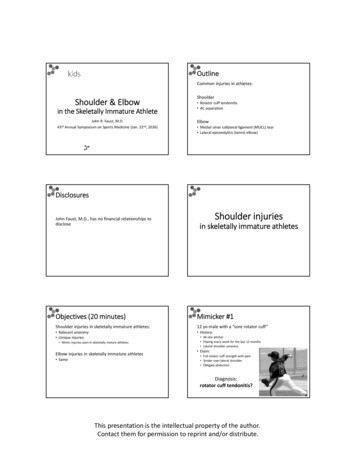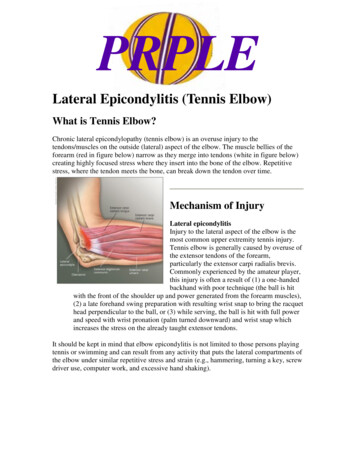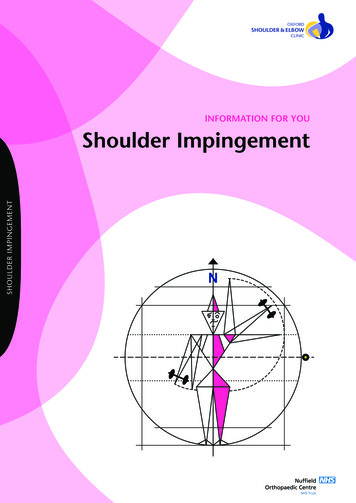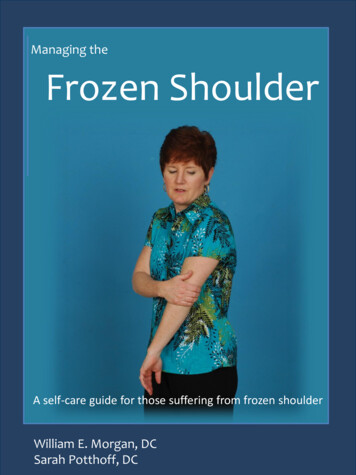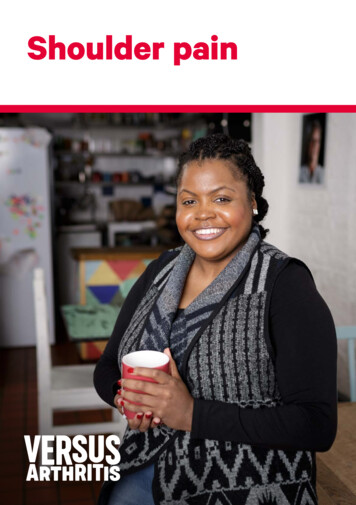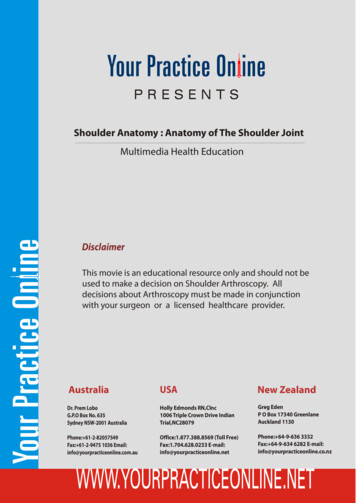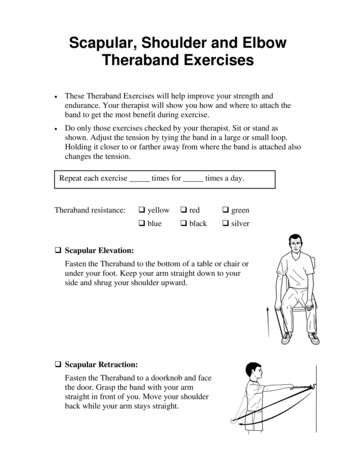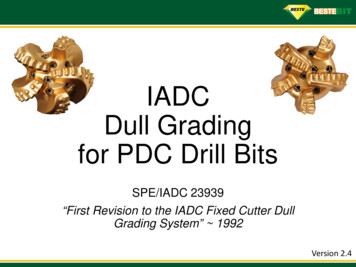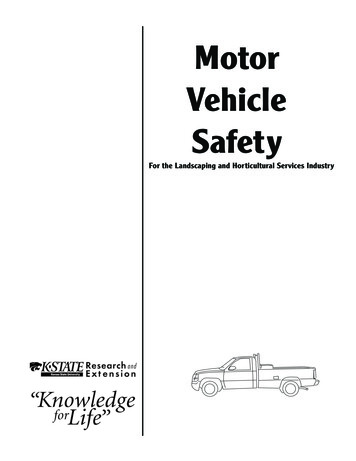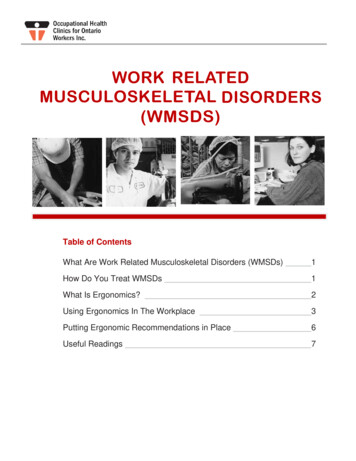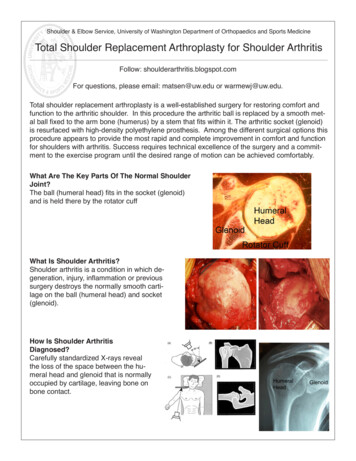
Transcription
Shoulder & Elbow Service, University of Washington Department of Orthopaedics and Sports MedicineTotal Shoulder Replacement Arthroplasty for Shoulder ArthritisFollow: shoulderarthritis.blogspot.comFor questions, please email: matsen@uw.edu or warmewj@uw.edu.Total shoulder replacement arthroplasty is a well-established surgery for restoring comfort andfunction to the arthritic shoulder. In this procedure the arthritic ball is replaced by a smooth metal ball fixed to the arm bone (humerus) by a stem that fits within it. The arthritic socket (glenoid)is resurfaced with high-density polyethylene prosthesis. Among the different surgical options thisprocedure appears to provide the most rapid and complete improvement in comfort and functionfor shoulders with arthritis. Success requires technical excellence of the surgery and a commitment to the exercise program until the desired range of motion can be achieved comfortably.What Are The Key Parts Of The Normal ShoulderJoint?The ball (humeral head) fits in the socket (glenoid)and is held there by the rotator cuffWhat Is Shoulder Arthritis?Shoulder arthritis is a condition in which degeneration, injury, inflammation or previoussurgery destroys the normally smooth cartilage on the ball (humeral head) and socket(glenoid).How Is Shoulder ArthritisDiagnosed?Carefully standardized X-rays revealthe loss of the space between the humeral head and glenoid that is normallyoccupied by cartilage, leaving bone onbone contact.
Shoulder & Elbow Service, University of Washington Department of Orthopaedics and Sports MedicineWhat Is A Total Shoulder?In a total shoulder, the arthritic surface of theball is replaced with a metal ball with a stemthat is press fit in the inside of the arm bone(humerus) and the socket is resurfaced with ahigh density polyethylene component.After a general or regional anesthetic, thisprocedure is performed through an incisionbetween the deltoid and the pectoralis majormuscles on the front of the shoulder. It includes release of adhesions and contracturesand removal of bone spurs that may blockrange of motion. Our team of surgeons,anesthesiologists, and surgical assistants usually perform this procedure in less than twohours.The arthritic surface of the ball is replacedwith a metal ball with a stem that is press fitdown the inside of the arm bone (humerus) sothat only the smooth surface extends from thebone.
Shoulder & Elbow Service, University of Washington Department of Orthopaedics and Sports MedicineHow Is The Humeral Component FixedIn The Humerus?While some surgeons cement the humeral component and others use implants that foster boneingrowth, we find that these approaches stiffen thebone making it more likely to fracture in a fall on onehand and greatly complicating any revision surgerythat may become necessary in the future on the other. We prefer to fix the component by impaction grafting the inside of the humerus (using bone harvestedfrom the humeral head that has been removed) untila tight press fit of the implant is achieved.How Is The Glenoid Component FixedTo The Glenoid Bone?The bone of the glenoid is precisely shaped with aglenoid reamer and then the glenoid component issecured with a combination of press fitting and cementing.In order for proper healing to occur, thepatient must maintain the range of motionachieved at surgery with simple, frequentstretching exercises.Rehabilitative exercises are started immediately after surgery using continuous passivemotion and stretching by the patient.Attaining and maintaining at least 150degrees of forward elevation is critical to thesuccess of this procedure. The forward leanand the supine stretch can be helpful ingetting there and maintaining this range ofmotion.
Shoulder & Elbow Service, University of Washington Department of Orthopaedics and Sports MedicineWho Should Consider A Total Shoulder?Surgery for shoulder arthritis should only be considered when the arthritis is limiting the quality of the patient’s life and after a trial of physical therapy and mild analgesics. Severe arthritis is usually best managed by either a partial or a complete joint replacement. Total shoulderarthroplasty (replacing the surfaces of both the ball and the socket) is usually considered byindividuals who want the best chance of a rapid recovery of shoulder comfort and the abilityto perform activities of daily living.Who Should Probably Not Consider A Total Shoulder Replacement?This procedure is less likely to be successful in individuals with depression, obesity, diabetes,Parkinson’s disease, multiple previous shoulder surgeries, shoulder joint infections, rotatorcuff deficiency and severely altered shoulder anatomy.What Are The Keys To Success Of A Total Shoulder?Success requires technical excellence of the surgery and participation by the patient in asimple exercise program until the desired range of motion can be achieved comfortably.How Does A Patient Prepare For The Total Shoulder Procedure?As for all elective surgical procedures, the patient should be in the best possible physical andmental health at the time of the procedure. Any heart, lung, kidney, bladder, tooth, or gumproblems should be managed before surgery. Any infection may be a reason to delay theoperation. Any skin problem (acne, scratches, rashes, blisters, burns, etc) on the shoulder orarm should be resolved before surgery. The shoulder surgeon needs to be aware of all healthissues, including allergies as well as the non-prescription and prescription medications beingtaken. For instance, aspirin and anti-inflammatory medication may affect the way the bloodclots. Some of these may need to be modified or stopped before the time of surgery.What Happens After Surgery?Total shoulder arthroplasty is a major surgical procedure that involves cutting of skin, tendonsand bone. The pain from this surgery is managed by the anesthetic and by pain medications.Immediately after surgery, strong medications (such as morphine or Demerol) are often givenby injection. Within a day or so, oral pain medications (such as hydrocodone or Tylenol withcodeine) are usually sufficient. The shoulder rehabilitation program is started on the day ofsurgery. The patient is encouraged to be up and out of bed soon after surgery and to progressively reduce their use of pain medications. Hospital discharge usually takes place onthe second or third day after surgery. Patients are to avoid lifting more than one pound, pushing and pulling for six weeks after surgery. Driving is recommended only after the shoulderhas regained comfort and the necessary motion and strength. This may take several weeksafter surgery. Thus the patient needs to be prepared to have less arm function for the firstmonth or so after surgery than immediately before surgery. For this reason, patients usuallyrequire some assistance with self-care, activities of daily living, shopping and driving for approximately six weeks after surgery. Management of these limitations requires advance planning to accomplish the activities of daily living during the period of recovery.
Shoulder & Elbow Service, University of Washington Department of Orthopaedics and Sports MedicineWhat About Rehabilitation?Early motion after a total shoulder replacement is critical for achieving optimal shoulderfunction.Arthritic shoulders are stiff. Although a major goal of the surgery is to relieve this stiffness byrelease of scar tissue, it may recur during the recovery process if range of motion exercisesare not accomplished immediately. For the first 6 weeks of the recovery phase, the focusof rehabilitation is on maintaining the motion that was recovered at surgery. Strengtheningexercises are avoided during the first 6 weeks so as not to stress the tendon repair before itheals back to the bone. Later on, once the shoulder is comfortable and flexible, strengtheningexercises and additional activities are started. Some patients prefer to carry out the rehabilitation program themselves. Others prefer to work with a physical therapist who understandsthe total shoulder program.When Can Ordinary Daily Activities Be Resumed?In general, patients are able to perform gentle activities of daily living using the operated armfrom two to six weeks after surgery. Walking is strongly encouraged. Driving should wait untilthe patient can perform the necessary functions comfortably and confidently. Recovery ofdriving ability may take six weeks if the surgery has been performed on the right shoulder,because of the increased demands on the right shoulder for shifting gears.With the consent of their surgeon, patients can often return to activities such as swimmingand golf at six months after their surgery.Once A Shoulder With A Total Shoulder Procedure Has Successfully Completed TheRehabilitation Program, What Activities Are Permissible?Once the shoulder has a nearly full range of motion, strength and comfort, we recommendthat the shoulder be protected from heavy lifting loads and from impact. Thus we discouragechopping wood, training with heavy weights, vigorous hammering, and recreational activitiesthat subject the shoulder to impact loading.What Problems Can Complicate A Total Shoulder And How Can They Be Avoided?Like all surgeries, the total shoulder operation can be complicated by infection, nerve orblood vessel injury, fracture, instability, component loosening, and anesthetic complications.Furthermore, this is a technically exacting procedure and requires an experienced surgeonto optimize the bony, prosthetic and soft tissue anatomy after the procedure. The procedurecan fail if the reconstruction is too tight, too loose, improperly aligned, insecurely fixed or ifunwanted bone-to-bone contact occurs. The most common cause of failure in the short termis a patient’s inability to maintain the range of motion achieved at surgery during the healingperiod, which can last up to six months after surgery. The most common long-term problemis wearing or loosening of the glenoid component.How Many Total Shoulder Surgeries Are Done At The University Of Washington?We currently perform over 80 of these procedures per year.
Shoulder & Elbow Service, University of Washington Department of Orthopaedics and Sports MedicineWhat If The Patient Lives A Long Way Away From Seattle?Patients often come to Seattle from a long distance for the procedure. We are available byappointment in the Shoulder and Elbow Clinic, 4245 Roosevelt Way N.E. Seattle, on Mondaysand Fridays to evaluate individuals with shoulder arthritis to discuss the procedures that mightbe most ideally suited for them. We perform surgery on Tuesdays and Wednesdays at the University of Washington Medical Center, 1959 NE Pacific St, Seattle, Washington, 206 598-4288.We also see patients at the Eastside Specialty Center, 1700 - 116th Ave NE, Bellevue, Washington, 425 646-7777. Patients having a total shoulder are usually able to return home threedays after the procedure, assuming they have mastered their exercises. The staples used toclose the skin can be removed by a nurse or physician near the patient’s home. Ideally, welike to see patients back at six weeks after surgery to assure that satisfactory progress is beingmade. We request that patients complete questionnaires at 3, 6, 12, 18 and 24 months aftersurgery so we can track their progress and that the patient obtain and send to us X-rays at 12and 24 months after surgery if they are unable to return to Seattle for the annual follow-ups. Allpatients have our personal email and the clinic contact phone numbers to use in contacting usat any time questions arise.What Are The Possible Complications Of This Procedure?This procedure involves a major operation conducted under general anesthesia. At the University of Washington we have the advantage of an experienced team of surgeons, anesthesiologists, nurses, and therapists all dedicated to patient safety and optimizing the quality of theresult. However, there are still risks associated with the procedure, including the small chancesof death, bleeding problems, heart problems, breathing problems, blood pressure problems, infection, nerve injury, blood clots, stiffness, pain, instability, fracture, tendon and muscle failure,breakage, loosening of the implants, and the need for revision surgery. These are essentiallythe same risks that exist for all joint replacement surgeries, such as total hips and total knees.We are happy to discuss these risks with you and to explain how we strive to prevent them andhow we manage them in the rare event that they occur.ConclusionSummary Of The Total Shoulder Procedure For Arthritis Of The ShoulderTotal shoulder arthroplasty is a well-established procedure for restoring comfort and function toshoulders damaged by arthritis.In the hands of an experienced surgeon, total shoulder replacement can be an effectivemethod for treating shoulders with damaged joint surfaces in a healthy and motivated patient.Pre-planning and persistent rehabilitation efforts will help assure the best possible result for thepatient.Frederick A. Matsen III and Winston J. WarmeShoulder SurgeonsUniversity of WashingtonDepartment of Orthopaedics and Sports Medicine
Shoulder & Elbow Service, University of Washington Department of Orthopaedics and Sports MedicineReferences:Matsen III, F.A.: Early Effectiveness of Shoulder Arthroplasty for Patients Who Have PrimaryGlenohumeral Degenerative Joint Disease. J. Bone and Joint Surgery, 78-A(2):260-264, 1996.Matsen III, F.A., Smith, K.L., DeBartolo, S.E., and Von Oesen, G.: A comparison of patientswith late-stage rheumatoid arthritis and osteoarthritis of the shoulder using self-assessed shoulder function and health status. Arthritis Care and Research 10:43-47, 1997.Rozencwaig, R., van Noort, A., Moskal, M.J., Smith, K.L., Sidles, J.A., and Matsen III, F.A.:The Correlation of Comorbidity with Shoulder Function and Health Status in Patients with Glenohumeral Degenerative Joint Disease. J. Bone and Joint Surg., 80-A(8):1146-1153, 1998.Matsen, F.A., III, Antoniou, J., Rozencwaig, R., Campbell, B., and Smith, K.L.: Correlates withcomfort and function after total shoulder arthroplasty for degenerative joint disease. J. Shoulder Elbow Surg., 9(6):465-469, 2000.Goldberg, B.A., Smith, K.L., Jackins, S., Campbell, B., and Matsen III, F.A.: The magnitudeand durability of functional improvement after total shoulder arthroplasty for degenerative jointdisease. J. Shoulder Elbow Surg., 10(5):464-469, 2001.Boorman, R., Hacker, S., Lippitt, S.B., and Matsen III, F.A.: A Conservative Broaching andImpaction Grafting Technique for Humeral Component Placement and Fixation in Shoulder Arthroplasty: The Procrustean Method. Techniques in Shoulder & Elbow Surgery. 2(3): 166-175,September 2001.Fehringer, E.V., Kopjar, B., Boorman, R.S., Churchill, R.S., Smith, K.L., and Matsen III, F.A.:Characterizing the functional improvement after total shoulder arthroplasty for osteoarthritis. J.Bone Joint Surg., 84A(8):1349-1353, 2002.Hasan, S.S., Leith, J.M., Campbell, B., Kapil, R., Smith, K.L., and Matsen III, F.A.: Characteristics of unsatisfactory shoulder arthroplasties. J. Shoulder Elbow Surg., 11(5):431-441, 2002.Lazarus, M.D., Jensen, K.L., Southworth, C., and Matsen III, F.A.: The radiographic evaluationof keeled and pegged glenoid component insertion. J. Bone Joint Surg., 84A(7):1174-1182,2002.Matsen III, F.A.: The relationship of surgical volume to quality of care: scientific considerationsand policy implications. J. Bone Joint Surg., 84A(8):1482-1483, discussion 1483-1485, 2002.Hacker, S., Boorman, R., Lippitt, S.B., and Matsen III, F.A.: Impaction grafting improves the fitof proximal humeral arthroplasty. JSES, 12(5):431-435, 2003.
Shoulder & Elbow Service, University of Washington Department of Orthopaedics and Sports MedicineBoorman, R., Kopjar, B., Fehringer, E., Churchill, R.S., Smith, K.L., and Matsen III, F.A.: Theeffect of total shoulder arthroplasty on self-assessed health status is comparable to that of totalhip arthroplasty and coronary artery bypass grafting. J. Shoulder Elbow Surg., 12(2): 158-163,2003.Hasan, S., Leith, J., Smith, K.L., and Matsen III, F.A.: The distribution of shoulder replacements among surgeons and hospitals is significantly different than that of hip or knee replacements. J. Shoulder and Elbow Surg., 12(2): 164-169, 2003.Matsen III, F.A., Rockwood Jr., C.A., and Iannotti, J.: Humeral fixation by press fit of a taperedmetaphyseal stem. A prospective radiograph study. J. Bone Joint Surg., 85A(2): 304-308,2003.Parsons, I.M. 4th, Campbell, B., Titelman, R.M., Smith, K.L., Matsen, F.A. III: Characterizingthe effect of diagnosis on presenting deficits and outcomes after total shoulder arthroplasty. JShoulder and Elbow Surg 14 (6): 575-94, 2005.Churchill, R., Kopjar, B., Fehringer, E., Boorman, R., Matsen, F.A. III: Humeral ComponentModularity May Not Be an Important Factor in the Outcome of Shoulder Arthroplasty for Glenohumeral Osteoarthritis. Am J Orthop 34 (4): 173-176, 2005.Franta AK, Lenters TR, Mounce D, Neradilek B, Matsen FA 3rd. The complex characteristics of 282 unsatisfactory shoulder arthroplasties. J Shoulder Elbow Surg. 2007 SepOct;16(5):555-62.Matsen FA 3rd, Bicknell RT, Lippitt SB. Shoulder arthroplasty: the socket perspective. J Shoulder Elbow Surg. 2007 Sep-Oct;16(5 Suppl):S241-7.Lee M, Chebli C, Mounce D, Bertelsen A, Richardson M, Matsen F 3rd.Intramedullary reamingfor press-fit fixation of a humeral component removes cortical bone asymmetrically. J ShoulderElbow Surg. 2008 Jan-Feb;17(1):150-5.Matsen FA 3rd, Clinton J, Lynch J, Bertelsen A, Richardson ML. Glenoid Component Failure inTotal Shoulder Arthroplasty. J Bone Joint Surg, 2008 Apr;90(4):885-96.
and golf at six months after their surgery. Once A Shoulder With A Total Shoulder Procedure Has Successfully Completed The Rehabilitation Program, What Activities Are Permissible? Once the shoulder has a nearly full range of motion, strength and comfort, we recommend that the shoulder be protected from heavy lifting loads and from impact.
